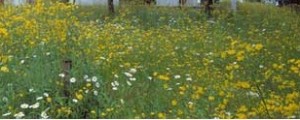 This credit rewards you for installing “drought-tolerant plants,” which helps reduce the need for irrigation. To figure out whether or not we get a point, we have to calculate the number of newly installed drought-tolerant plants as a percentage of the total newly installed plants. If the total is 90% or more, we get two points; if its is 45%-89%, we get one point. Less than 45%: zippo.
This credit rewards you for installing “drought-tolerant plants,” which helps reduce the need for irrigation. To figure out whether or not we get a point, we have to calculate the number of newly installed drought-tolerant plants as a percentage of the total newly installed plants. If the total is 90% or more, we get two points; if its is 45%-89%, we get one point. Less than 45%: zippo.
But what, exactly, is a drought-tolerant plant? I think of them as cactus — prickly pear, saguaros, teddy bear cholla, etc. Are we supposed to plant those in Minnesota? That’s probably overkill. It seems to me that native trees, shrubs, and plants would be considered “drought-tolerant” because they survive in our climate without supplemental watering. And that is the main point — design landscaping that requires less potable water. So for Minnesota, there is a long list of trees and shrubs that survive well without supplemental watering. (See the University of Minnesota’s list online.)
Our situation, I think, is unique (aren’t they all?). We had several river birches thriving on our property without any extra irrigation on our part, but they were definitely getting extra water from our wet wet wet soil as well as from the underground river running beneath our house. We did plant another birch (Heritage variety), but I would not count that one among the drought-tolerant plants. We also installed 3 white pines and 5 serviceberries, which, according to about.com, are drought-tolerant. We planted 81 techny arborvitae to provide a natural fence as opposed to a man-made fence; I am not counting those as drought-tolerant because I do not find them on a list, and we do have drip irrigation for them. So far, then, our percentage is very low.
However, we actually have a large area of our landscaping that is devoted to native prairie grasses and wild flowers — an area that is not irrigated, so, by definition, it is drought-tolerant. We have had to install many plants (in addition to seeding) in order to get this area established. The number of plants we installed (738 little blue stem, coreopsis, aster, e.g.) completely dwarfs the number of new trees we installed, so we end up with a fairly high percentage of the total. All in all, we get to 90.1% of our plants considered to be drought-tolerant. We’ll take those two points, thank you!
Sustainable Sites points so far: 3
Cumulative points: 17
Additional points needed to get to Gold: 71
